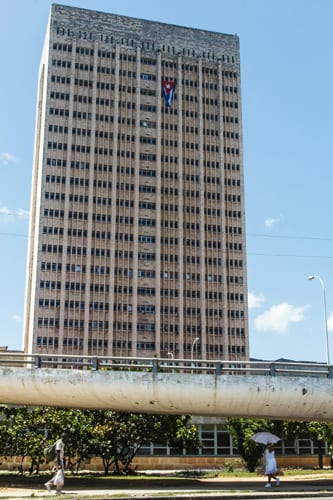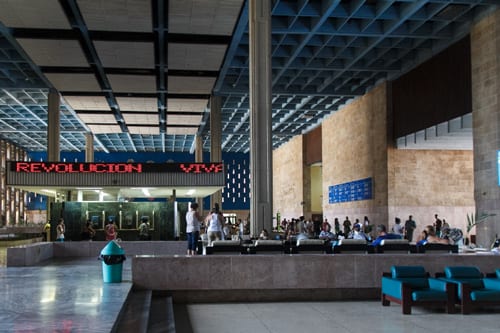Investment in Cuba’s Public Health: True of False?
By Rogelio M. Díaz Moreno

HAVANA TIMES — A fellow writer for HT recently brought up some pretty serious questions. Erasmo Calzadilla expressed his doubts relating to the supposed development of the investment process in the Cuban health system. These concerns are naturally shared by many of us. I think it’s only fair in every sense, to demand transparency in the management of public affairs in a republic.
I think I can help Calzadilla out a little bit. At the very least I can give him a few insights, relating to the modest advances we’ve made in the sector in which I work. Maybe he hasn’t heard about these advances, which could well be good reason for his speculation. I just happen to work in Radiotherapy, one of the most widespread ways to treat cancer.
Unfortunately, cancer-related illnesses are the number one cause for deaths in Cuba. As our colleague well knows, it is estimated that this will ring true in the coming years because of Cuba’s population dynamic. And almost half of those affected receive Radiotherapy at some point of their treatment. It cures a significant number; and for others, it helps relieve the illness for a while at least.
I began working at the National Institute for Radiation Oncology and Biology (INOR) in 2007. At that time, the radiotherapy centre had one cobalt unit and a linear accelerator, as well as a brachytherapy machine. There were a few more cobalt and brachytherapy machines scattered across the country.
Up until this year, 2016, you could say that there has been a significant amount of investment made. Four more brand new linear accelerators and cobalt units have been installed in different parts of the country. Some of the old cobalt units have undergone major maintenance, which have greatly improved their functionality. New brachytherapy equipment has also been installed or older machines replaced. Over the next few days, a couple more linear accelerators will also be installed for carrying out specific procedures inside the operating room. Furthermore, we’re currently trying to get hold of superficial radiotherapy equipment. The cheapest of these machines costs no less than hundreds of thousands of dollars; the most expensive costing three million.
Advances in radiotherapy don’t entirely depend on the equipment used for treatment. They also need modern software to calculate doses, as well as dosimetry and extremely sophisticated quality control instruments. All of this costs a great deal. Radiotherapy departments across the country have also received their share.
Alongside radiotherapy, extensive work is being carried out in order to stabilise stereotactic radiotherapy procedures depending on the great determination of lots of people. This happened for some time, but outdated equipment meant a need for a new system, new investments, etc. A simple computer in my office has the planning programme of Radiosurgery treatments on it, which is currently being installed by INOR. It costs something like $2.5 million, so nobody can take it.

I could also tell you about the branch in Nuclear Medicine. This type of practice uses radioisotopes to accurately diagnose cancer and other illnesses. Again, it’s clear that extremely sophisticated equipment has been purchased and is used to help those who need it.
Investments have also been made in training medical personnel. Hundreds of professionals pass training courses abroad. In this respect, I myself went to Albion a few months ago for such a training; although sharp tongues only spoke of the few things I confessed I’d brought back with me.
I can’t speak for other medicine specialties because I don’t know them anywhere near as much as I know my own. With respect to the reader, I’ll leave those questions to be answered by people who are better informed than I.
It’s true that all of our needs are not met. We know that, we experience it and suffer because of it everyday. Can you imagine how much worse off we’d be if the investment process I’ve just outlined hadn’t been taking place over the last decade? Like anything human, mistakes have been made, there have been setbacks and there’s still a lot of room for improvement. Many of us believe in the constructive role criticism can play, when followed with a sincere commitment to support these concerns with our own input.
And finally, the part most of you don’t want to hear. The famous trade embargo has inflicted a lot of damage to our speciality, really criminal. There have been instances when sales contracts to Cuba have been cancelled because the factories in question had been bought out by US companies. The ensuing delay, corresponding to the need to find a new supplier, has meant nothing less than the number of patients who weren’t able to receive their life-or-death therapy in time.
I can also state another cause for concern. There are only two companies in the entire world who manufacture linear accelerators and one of them is from the US. It was only recently that, in accordance with normalizing relations between our two countries, they put together all the licences required and showed their catalogue to Cuban institutions. Up until now, the other seller had taken their de facto monopoly for granted and had squeezed every cent they could out from our Ministry of Health whilst charging exorbitant prices.
To sum things up, it’s possible that many people are unaware of the country’s investment process and the installment of medical equipment in Cuba. However, these processes do indeed play an important role and have a significant impact on the lives of all of those involved, both those who go to a health facility needing to be seen and those who work there.

Yes! The medical staff are very good and are to be admired for the quality of the services they provide despite working in hospitals where there are broken windows, doors minus handles, crumbling staircases and insanitary washrooms.
That is indeed mostly true, Fez. I have however taken Cuban friends into the Cira Garcia Hospital. Through the back door and under the radar, yes, but they did get treatment reserved only for foreigners.
Everything has a price and Cuba is no different.
Cubans are not allowed to even enter private clinics in Cuba, even if they have CUC.
Even the most fervent supporter of the Revolution will admit that you need a connection to get decent dental care in Cuba. The clinic down the street from my casa in Havana has NEVER had Novocaine or local anaesthetic available unless you pay under the table.
I’ve been to many, many hospitals and clinics all over the island and 70% of the time the conditions are dismal, 20% of the time they’re simply bad, and 10% of the time they’re acceptable.
Disagree. However, maybe you were there on a good day.
I have replied to the same question from Moses, and the short answer is “Yes”, I have visited a Cuban hospital and I have received dental care in Cuba. Have you?
I have received dental care in Cuba, from a clinic set up for Cubans. There was no charge but did tip both the dentist and his assistant. I have also visited the Hermanos Ameijeiras Hospital, out of curiosity having seen the footage of it in the Michael Moore film Sicko. It did not stink of disinfectant or urine.
Have you actually received medical services in Cuba? I should be more specific, not as a tourist would from the hospitals and clinics set up for tourists and Cubans who can pay in CUC, but from a Cuban facility set up for Cubans? Not likely. You have no idea what you are talking about.
Rogeloio said nothing whatsoever about the general services available to the Cuban people. In general they suck. If you had ever visited a real Cuban hospital you’d know this. Stop drinking the propaganda Kool-Aid.
For the uninformed reader: the photo of the hospital at the top of the post is misleading. I have a friend who works in that building whom I have visited at work many times. I’m guessing a third of the building is vacant. Many of the occupied floors are dark or dimly lit. The hospital stinks of disinfectant and urine. And the air-conditioning? What air-conditioning? This building is symbolic of what is happening to Cuban health care. It’s a shell of its former self.
Thank you Rogelio, for this very informative and balanced insight. I have found Cuban people generally speak highly of the medical and educational services provided to them, and your report confirms there is good reason for them to do so. The contributors who constantly deny the impact of the US embargo on the Cuban economy and the wellbeing of it’s population will hopefully now also have a better understanding of the harm it causes.